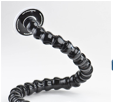Building an Assistive Technology (AT) Glider
 |
| AT Glider |
This project was created for a 6 year-old boy needing to work on gross motor skills and balance. He loved push-toys like shopping carts and strollers but they weren’t the appropriate height for him. To maintain a better posture for his balance, I wanted to create something that allowed him to push while standing straight up. The idea of this glider came from collaboration with Dr. Therese Willkomm.
The idea is that the glider has vinyl flashing on the underside to allow it to be used indoors or outdoors in the grass. The glider can be used with or without weight to accommodate the child’s abilities and needs.
What do you need to build a glider?
Materials:
- PVC pipe: straight pieces, T pieces, right angle pieces
- PVC pipe cutter
- LocLine base and connecting balls
- LocLine tool
- Cementing glue
- Corrugated plastic
- Coro-Cutter (tool for cutting corrugated plastic)
- Vinyl flashing
- 25lbs. circular free weight (or other amount)
- Double-sided adhesive foam tape
- U-Glue
- Corner guard: 3 2’inch pieces
- Scotch double-sided, clear plastic adhesive
- Silver Sharpie marker
Procedure:
- First cut a piece of corrugated plastic into about an 2ft by 1.5ft rectangle
- Cut a piece of vinyl flashing to the same size as the corrugated plastic rectangle
- Affix the vinyl flashing to one side of the corrugated plastic with Scotch double-sided, clear plastic adhesive, one piece for each corner of the flashing. Make sure flashing is flat against the plastic
- Cut PVC pipe to length, matching the height to how tall the child’s arms are at in a pushing position in front of them
- Connect PVC pieces with a T part if more than one piece is necessary for height
- Insert LocLine base and connecting joints into one end of the PVC pipe. LocLine should be tall enough when
protruding from center of weight to allow for rotation of the PVC pipe handle
LocLine base and connecting balls - Determine where the center of the glider should be and use LocLine base as a marker of location
- Test to see that the LocLine base can fit flat underneath the 25lbs weight, with the LocLine extension and PVC pipe protruding from the center circle hold in the weight
- Use silver sharpie marker to mark location of base for adhesive addition to be accurate
- Use U-Glu on the bottom of the LocLine base to affix the base to the side of the corrugated plastic WITHOUT the vinyl flashing. The vinyl flashing should be on the opposite side of the weight and handle
- Once base has been affixed to the plastic, weight can be put back on over the base where the LocLine comes out of the center hole of the weight
- Use corrugated plastic in 4 inch pieces which has been folded upon itself to create double the thickness with foam tape as the adhesive
- Attach another 4-inch piece of doubled corrugated plastic onto each piece of doubled corrugated plastic in order to make the 4 inch long pieces 4 times high each
- Using foam tape, attach the 4 inch long pieces around the perimeter of the weight in an octagonal shape, to keep the weight from sliding excessively
- To secure the corrugated plastic barrier, affix three pieces of corner guard to the front three pieces of corrugated plastic with the L shape against the corrugated plastic pieces, using the Scotch double-sided clear plastic tape
- To finish, attach a T piece of PVC pipe to the top of the PVC pipe that is sticking out from the center of the glider
- On either side of the T piece, attach a 5 inch piece of PVC pipe
- On each 5 inch piece of PVC pipe, attach a right angle elbow piece of PVC pipe to create a downward facing handle
This process required trial and error - There are always lessons to be learned when creating AT.
When the device was first tested with the boy, he was unable to push the glider with the 25lb. weight on it. This is why the weight is detachable and it is never affixed to the glider, to allow for interchangeability. I removed the weight which helped the boy to keep the handle upright, instead of him falling down on top of the handle. He was able to push the glider around with relative ease once the weight was removed, and walked with very straight and stable movement. I would have liked to try a lighter weight, maybe 10lbs. to see if he would have been able to push the cart with that much weight. Also, the test run was done indoors on hardwood floor. I would have liked to test how he would have been able to handle the traction outdoors on the grass, and if there would have been any difference in his ability to walk with confidence. One possible adjustment to be made would be to anchor the handle in two locations. Though the current design allows for variability in height of the handle and degree to which the glider can be turned, it does not offer much stability and is easily pushed over. If the glider’s handle had two points of anchor to the corrugated plastic, perhaps the boy would have an easier time pushing more weight, and the glider would be more stable if he needed to lean on it more.
Overall he really enjoyed pushing the glider around in circles around his house, and his mom and dad were excited to see him accomplishing this task!
 Hi, my name is Katie McKay! This is my second year in the EC-SEAT program at UNH and I am very excited to be working in a preschool and kindergarten setting. I am completing my internship at Glen Lake School in Goffstown, NH with an early childhood special educator. I am also working part-time at the Moore Center in Manchester doing mandatory state reporting for Early Supports and Services. I have lots of experience with individuals with disabilities in recreational settings so my learning focus in on children with disabilities in academic settings. In my spare time I enjoy reading, traveling around New England, and spending time with family and friends. My focused interests are in assistive technology, dual language learners, and low-incidence disabilities.
Hi, my name is Katie McKay! This is my second year in the EC-SEAT program at UNH and I am very excited to be working in a preschool and kindergarten setting. I am completing my internship at Glen Lake School in Goffstown, NH with an early childhood special educator. I am also working part-time at the Moore Center in Manchester doing mandatory state reporting for Early Supports and Services. I have lots of experience with individuals with disabilities in recreational settings so my learning focus in on children with disabilities in academic settings. In my spare time I enjoy reading, traveling around New England, and spending time with family and friends. My focused interests are in assistive technology, dual language learners, and low-incidence disabilities.
 Hi, my name is Katie McKay! This is my second year in the EC-SEAT program at UNH and I am very excited to be working in a preschool and kindergarten setting. I am completing my internship at Glen Lake School in Goffstown, NH with an early childhood special educator. I am also working part-time at the Moore Center in Manchester doing mandatory state reporting for Early Supports and Services. I have lots of experience with individuals with disabilities in recreational settings so my learning focus in on children with disabilities in academic settings. In my spare time I enjoy reading, traveling around New England, and spending time with family and friends. My focused interests are in assistive technology, dual language learners, and low-incidence disabilities.
Hi, my name is Katie McKay! This is my second year in the EC-SEAT program at UNH and I am very excited to be working in a preschool and kindergarten setting. I am completing my internship at Glen Lake School in Goffstown, NH with an early childhood special educator. I am also working part-time at the Moore Center in Manchester doing mandatory state reporting for Early Supports and Services. I have lots of experience with individuals with disabilities in recreational settings so my learning focus in on children with disabilities in academic settings. In my spare time I enjoy reading, traveling around New England, and spending time with family and friends. My focused interests are in assistive technology, dual language learners, and low-incidence disabilities.


Comments
Post a Comment
We invite you to share your thoughts and additional resources with our community of readers.
Also, contact us if you would like to be a guest blogger.